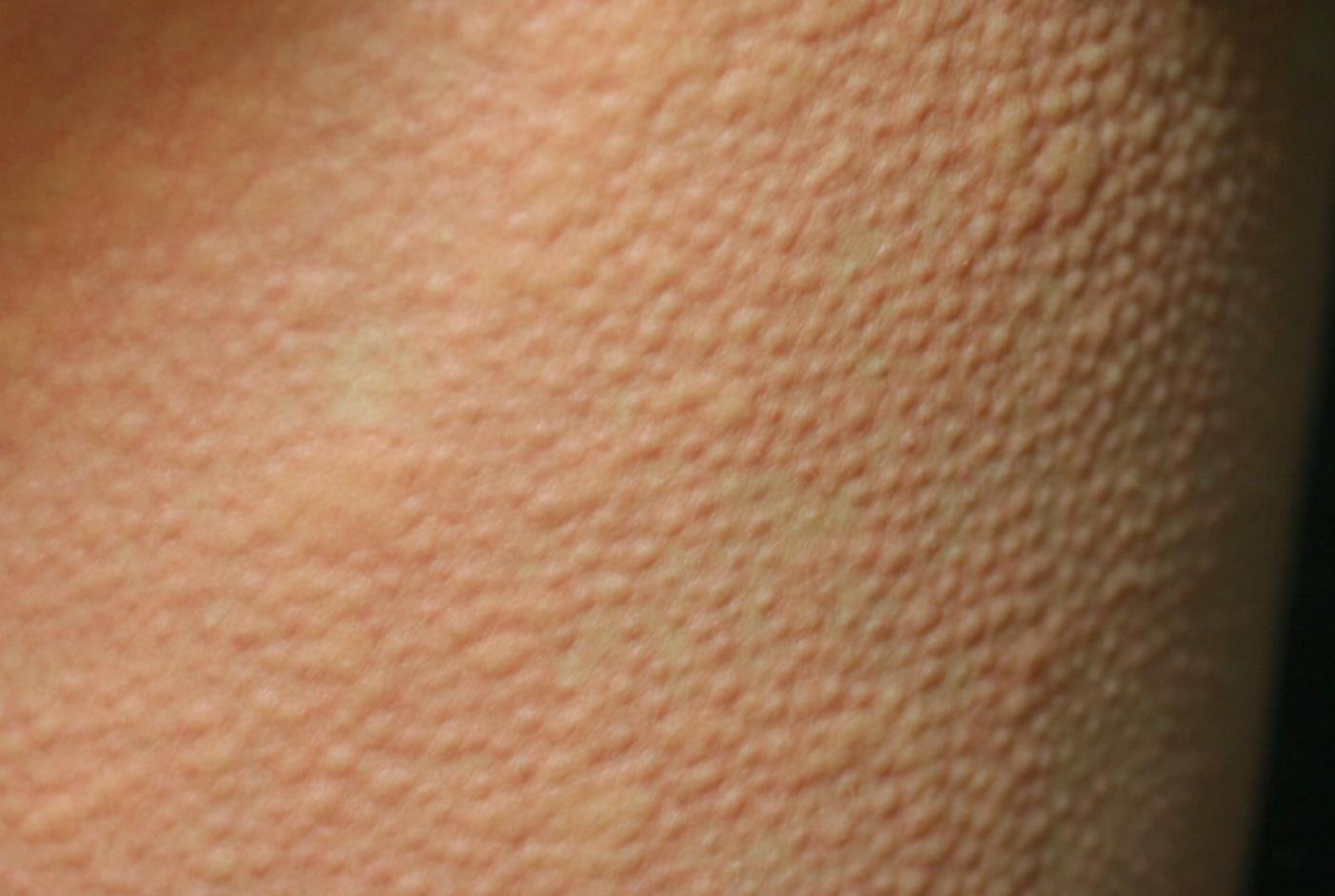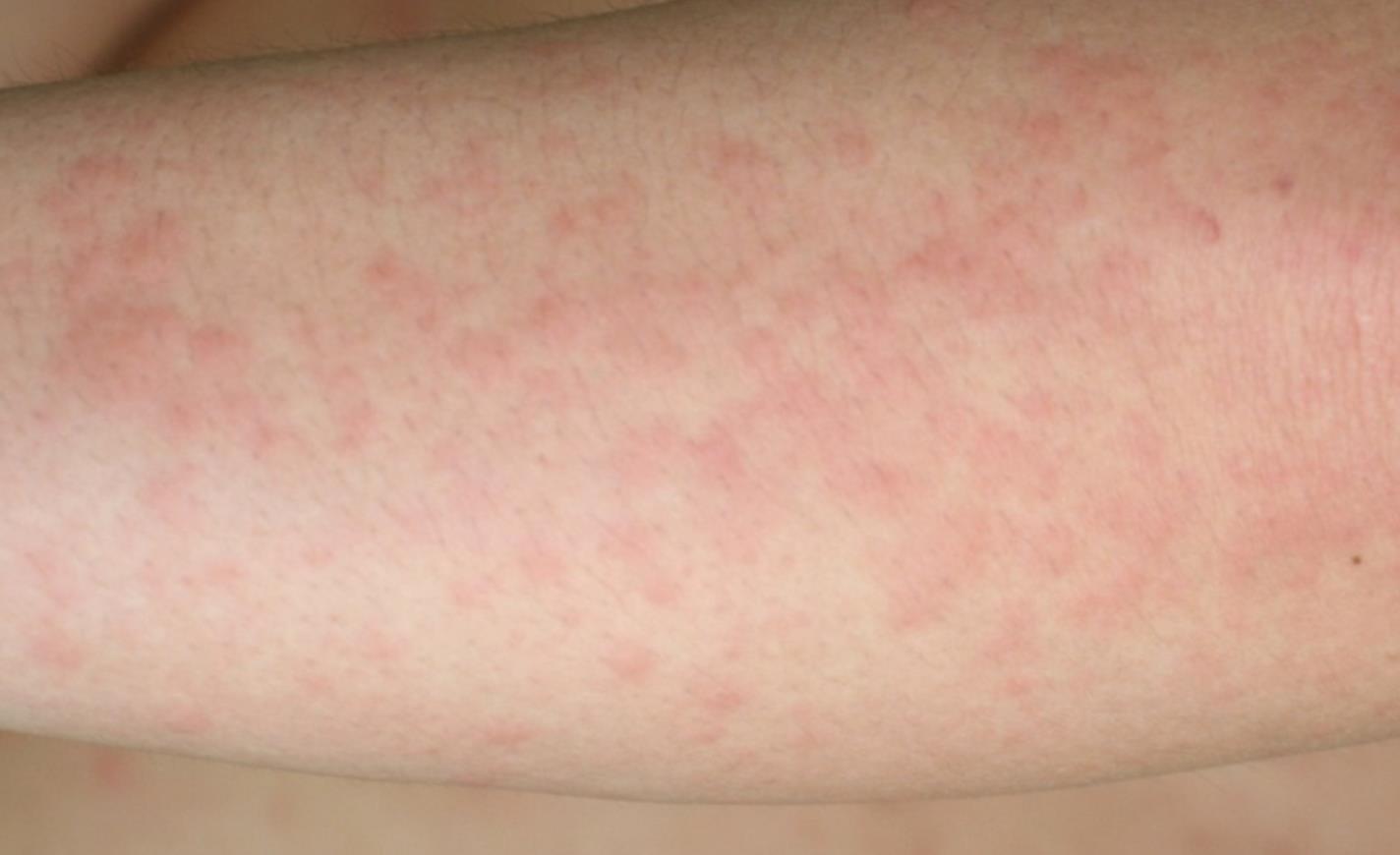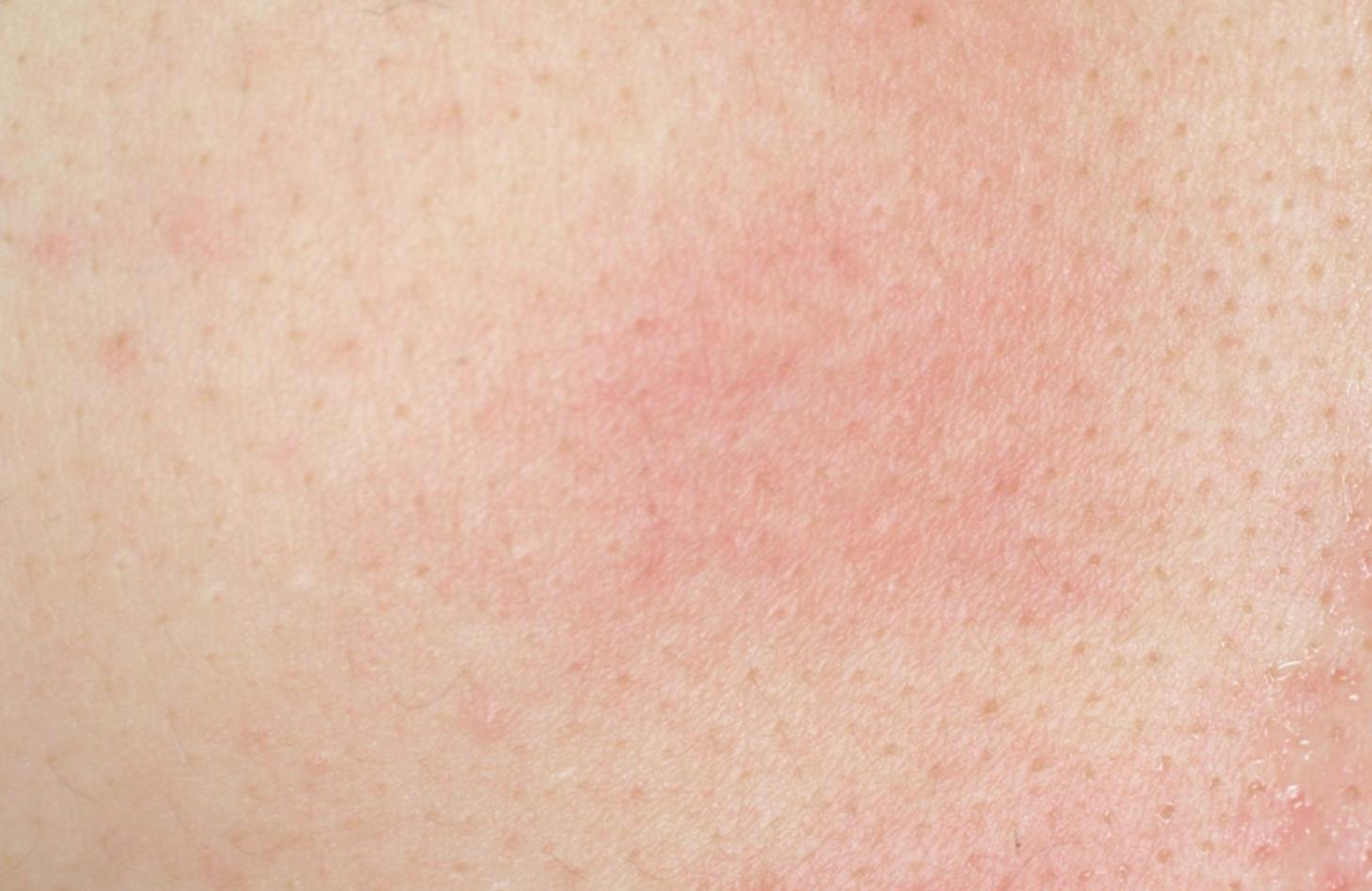Cholinergic urticaria
OVERVIEW
What is cholinergic urticaria?
Cholinergic urticaria is a type of urticaria. It is primarily triggered by factors such as fever (axillary temperature exceeding 37.2°C), exercise (e.g., playing badminton), emotional stress, hot baths (water temperature > 42°C), hot beverages, and spicy foods (e.g., chili peppers)[1].
The skin typically develops small red bumps, about 1–3 mm in diameter, surrounded by redness and possibly appearing swollen, known as wheals. These usually subside on their own within a short period[1].
Is cholinergic urticaria common?
Cholinergic urticaria is relatively common, accounting for 5% of chronic spontaneous urticaria (recurrent urticaria lasting at least 6 weeks). This means 5 out of every 100 patients with chronic spontaneous urticaria also have cholinergic urticaria, while the global prevalence of chronic spontaneous urticaria is approximately 1%. The condition typically occurs between the ages of 18 and 44, affecting both men and women equally with no significant gender difference[1,2].
SYMPTOMS
What are the common manifestations of cholinergic urticaria?
The common manifestations of cholinergic urticaria are usually limited to the skin. In the initial stage, it presents as wheals (red, swollen raised areas on the skin) 1–3 mm in diameter, accompanied by erythema[3]. Most appear within 6 minutes of exposure to the causative factor and gradually disappear after about 30–120 minutes[4].
As the reaction progresses, the erythema may merge to form large patches[1].
Itching, tingling, burning sensations, or localized heat are often experienced[3].



Where does cholinergic urticaria commonly occur?
Cholinergic urticaria can occur anywhere on the skin but is more frequently seen on the chest, face, upper back, and arms[4].
What severe complications can cholinergic urticaria cause?
If large amounts of mediators (substances that trigger urticaria) are released from the affected skin areas and enter the body, systemic symptoms may occur.
Systemic symptoms are relatively rare and may include one or more manifestations, such as headache, dizziness, low blood pressure (systolic pressure < 90 mmHg), angioedema (swelling of subcutaneous loose tissue or mucous membranes, often affecting the lips or throat), difficulty breathing, rapid heartbeat, shortness of breath, diarrhea, and abdominal pain. In severe cases, these symptoms may be life-threatening[3,4].
CAUSES
What are the causes of cholinergic urticaria?
Cholinergic urticaria is generally triggered by nerve fibers in sweat glands[4]. When body temperature rises, the skin reacts to heat and sweat, and any factor that increases core body temperature (i.e., what we commonly refer to as body temperature) may induce cholinergic urticaria.
The most common triggers include high-temperature environments (e.g., hot showers, hot weather), intense exercise, and emotional stress (extreme agitation or anger leading to increased sweating)[1].
Who is most likely to develop cholinergic urticaria?
It commonly occurs in young adults (aged 18–44), primarily triggered by exercise, consuming hot beverages, or emotional tension[3].
If the body has an autoimmune reaction to an antibody (i.e., immunoglobulin IgE) in its own sweat, cholinergic urticaria may develop[1].
Individuals with eczema, asthma, other allergies (e.g., pollen), or urticaria caused by other factors (e.g., certain foods, medications, skin pressure, or cold weather) may be more susceptible to cholinergic urticaria[4].
Is cholinergic urticaria hereditary?
No. There is insufficient evidence to prove that cholinergic urticaria is hereditary.
DIAGNOSIS
How is cholinergic urticaria diagnosed?
If there are typical triggers (such as hot showers, intense exercise, etc.) and typical skin lesions of cholinergic urticaria (manifesting as skin redness, itching, swelling, and raised welts a few minutes after exercise or a hot shower), this is usually sufficient to confirm the diagnosis[1,4].
The doctor may ask about the patient's rash presentation, duration, and possible related factors (such as extreme emotional distress, hot showers, etc.)[1].
What tests are needed to diagnose cholinergic urticaria?
Generally, only a medical history and examination of the rash are required, with no additional tests needed. The following tests may help further evaluation:
- Under medical supervision, running or cycling on a stationary bike for about 15 minutes to observe whether rashes appear due to sweating[4]. If symptoms (skin swelling with redness, itching, etc.) occur, this supports a diagnosis of cholinergic urticaria.
- The doctor may apply a 1:5000 acetylcholine solution to the skin and observe for symptoms, which can aid in diagnosis[3].
- Immersion of the torso and limbs in 42°C hot water for up to 15 minutes while recording body temperature changes to ensure a rise of at least 0.7°C. If symptoms appear beyond the immersed skin, this supports the diagnosis[1].
What conditions can cholinergic urticaria be confused with? How to differentiate them?
Cholinergic urticaria is easily confused with localized heat urticaria and exercise-induced anaphylaxis, as all three can cause itching and wheals (red, raised skin swellings). They can generally be distinguished by triggers and wheal size:
Cholinergic urticaria: The most common triggers are high-temperature environments (e.g., hot showers, hot weather), intense exercise, and emotional stress (extreme agitation or anger leading to increased sweating). Wheals typically appear within 6 minutes of exposure, measuring 1–3 mm in diameter[1].
Localized heat urticaria: This occurs only when heat directly contacts the skin. Wheals develop within minutes (usually within 10 minutes) at the contact site. Antihistamines are usually ineffective for this condition[5].
Exercise-induced anaphylaxis: Unlike cholinergic urticaria, exercise is the sole trigger. Wheals in this condition are typically larger (10–15 mm in diameter) than those in cholinergic urticaria[1,6].
Are cholinergic urticaria and heat urticaria the same condition?
No.
Cholinergic urticaria is sometimes called "generalized heat urticaria" and is related to cholinergic nerve impulses or sweat gland activation. Wheals can occur anywhere on the body[1].
Heat urticaria, also known as "heat contact urticaria," is associated with mast cell activation and occurs only where heat (e.g., sunlight) directly affects the skin. It is divided into delayed familial heat urticaria (wheals appear 1–2 hours after 43°C water exposure) and localized heat urticaria (wheals appear within 10 minutes of 43°C water exposure)[3,5].
TREATMENT
Which department should I visit for cholinergic urticaria?
Dermatology.
Can cholinergic urticaria resolve on its own?
Yes. For a single episode of cholinergic urticaria, symptoms typically disappear on their own within about 30 to 120 minutes[4]. However, recurrence is possible upon re-exposure to triggers, with symptoms lasting anywhere from 3 to 16 years[1].
How is cholinergic urticaria treated?
Managing cholinergic urticaria involves identifying and avoiding known triggers, followed by symptomatic treatment with medication to alleviate rashes and itching.
-
Avoiding triggers: Common triggers include fever (axillary temperature > 37°C), exercise (e.g., playing badminton), emotional stress, hot showers (water temperature > 42°C), hot beverages, and spicy foods (e.g., chili peppers, scallions)[1]. Helpful measures may include:
- Applying cold, damp towels to the skin;
- Taking cool showers;
- Using fans to cool down;
- Keeping indoor temperatures cool (18–22°C) with air conditioning in summer;
- Wearing loose clothing;
- Managing stress and staying calm;
- Stopping or reducing physical activity during flare-ups.
-
Medications:
-
Antihistamines, used for allergies, may help control symptoms like rashes and itching. Options include cetirizine, loratadine, hydroxyzine, diphenhydramine, and fexofenadine (possible side effects: fatigue, headache, dry mouth). Daily use is more effective than as-needed dosing[4].
-
If antihistamines are ineffective, a doctor may prescribe alternatives (e.g., short-term corticosteroids like prednisone, which may cause side effects like moon face and muscle wasting with long-term use) for better symptom relief[1,4].
-
Does cholinergic urticaria require hospitalization?
Hospitalization is unnecessary if symptoms are limited to the skin. However, life-threatening systemic reactions (e.g., difficulty breathing) may require inpatient monitoring and treatment[4].
What are the common side effects of medications for cholinergic urticaria?
Antihistamines like cetirizine and loratadine are generally safe with minimal side effects. First-generation antihistamines (e.g., hydroxyzine, diphenhydramine) may cause drowsiness, poor concentration, fatigue, or dizziness[7], though these are not guaranteed. Corticosteroids (e.g., prednisone) are not routine treatments and are used short-term in select cases. Long-term or high-dose use may lead to obesity, high blood sugar (fasting glucose ≥ 6.1 mmol/L), hypertension (systolic ≥ 140 mmHg with/without diastolic ≥ 90 mmHg), edema, hypokalemia (weakness, nausea, vomiting), mood changes, or peptic ulcers[8].
Can cholinergic urticaria be completely cured?
A complete cure cannot be guaranteed. The prognosis is generally good, but symptoms may recur for 3–16 years (average: 7.5 years), with ~1/3 of cases lasting over a decade[1].
DIET & LIFESTYLE
What should patients with cholinergic urticaria pay attention to in their diet?
Special attention should be paid to hot drinks and spicy foods (such as chili peppers, scallions, etc.).
Theoretically, heat stimulation and spicy stimulation may trigger cholinergic urticaria[1]. If these factors indeed induce symptoms in practice, targeted avoidance is necessary. If hot drinks and spicy foods do not cause cholinergic urticaria, avoidance is not required.
What should patients with cholinergic urticaria pay attention to in daily life?
Be mindful of factors that may cause or worsen cholinergic urticaria.
In addition to the aforementioned hot drinks and spicy foods (such as chili peppers, scallions, etc.), other triggers may include exercise (e.g., playing badminton), fever (axillary temperature > 37°C), hot baths (water temperature > 42°C), and mental stress. If specific triggers are identified, they should be avoided as much as possible[1].
Can patients with cholinergic urticaria exercise?
Vigorous exercise in hot environments (e.g., difficulty speaking after exercise, excessive sweating) generally triggers cholinergic urticaria and should be moderately avoided[1]. If moderate-intensity exercise (such as walking or jogging) does not induce cholinergic urticaria, strict avoidance is unnecessary.
Does cholinergic urticaria require follow-up? How is it conducted?
Cholinergic urticaria requires follow-up. The doctor will primarily inquire about treatment progress and symptom control during therapy. Medication plans will be adjusted based on symptom control. Other tests are usually unnecessary.
Does cholinergic urticaria affect fertility?
Cholinergic urticaria does not affect fertility.
PREVENTION
Can cholinergic urticaria be prevented? How to prevent it?
Cholinergic urticaria can be prevented. Preventive measures involve identifying and avoiding triggers that cause cholinergic urticaria. This is also an effective way to prevent recurrence. These measures include:
- If a certain type of exercise triggers cholinergic urticaria, avoid it or switch to other forms of exercise;
- Avoid excessively hot water when bathing (water temperature should not exceed 42°C);
- Wear loose-fitting clothing;
- Keep the room temperature cool, generally between 18–22°C;
- Avoid excessive mental stress and relax by listening to music, traveling, etc.[1,4].
How can patients with cholinergic urticaria prevent other related diseases?
Promptly avoiding triggers (such as hot water or hot environments) and adhering to daily medication can help reduce the risk of other complications (e.g., swelling of the lips or throat) to some extent[4].
Additionally, in cases of severe reactions such as rapid breathing or difficulty breathing, a doctor may prescribe an epinephrine injection to be kept on hand. This can help improve breathing, control swelling, and save lives[4].
